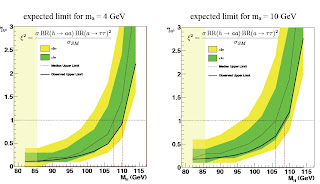There is one more reason, this time purely theoretical, to expect that the Higgs may be lighter than the naive LEP bound. If supersymmetry is relevant at the weak scale it is in general very uncomfortable with a heavy Higgs. Well, they keep telling you that the upper limit in the MSSM is 130 GeV. But that requires stretching the parameters of the model to the point of breaking, while the natural prediction is 90-100 GeV. Indeed, not finding the Higgs at LEP is probably the primary reason to disbelieve that supersymmetry is relevant at low energies.
Is it possible that Higgs is lighter than 115 GeV and LEP missed it? The answer is yes, because the LEP searches have left many loopholes. Sensitivity of LEP analyses deteriorates if the Higgs
 decays into a many-body final state, which is possible in some extensions of the standard model. One popular theory where this could happen is the NMSSM - the 2.0 version of the MSSM with an additional singlet. Roughly, the Higgs could first decay into the new singlet, who in turn decays into two tau leptons, which amounts to Higgs decaying into four tau leptons. This funny decay topology could escape LEP searches even if the Higgs is as light as 86 GeV! That is the case not because of deep physical reasons, but simply because LEP collaborations were too lazy to search for it (in comparison, Higgs decaying into four b-quarks, which was studied by LEP, is excluded for the Higgs mass up to 110 GeV).
decays into a many-body final state, which is possible in some extensions of the standard model. One popular theory where this could happen is the NMSSM - the 2.0 version of the MSSM with an additional singlet. Roughly, the Higgs could first decay into the new singlet, who in turn decays into two tau leptons, which amounts to Higgs decaying into four tau leptons. This funny decay topology could escape LEP searches even if the Higgs is as light as 86 GeV! That is the case not because of deep physical reasons, but simply because LEP collaborations were too lazy to search for it (in comparison, Higgs decaying into four b-quarks, which was studied by LEP, is excluded for the Higgs mass up to 110 GeV).But not anymore - this particular gaping hole has been recently sealed. A group of brave adventure-seekers ventured into CERN caverns, excavated the ancient LEP data and analyzed them lookig for the Higgs-to-4tau signal. The results were presented this week at the ALEPH meeting celebrating the 20th anniversary and 9th anniversary of its demise. Of course, there is nothing there, in case you had any doubts. The new limit for the Higgs-to-4tau channel excludes the Higgs mass smaller than 105-110 GeV. Yet the beautiful thing in that analysis is that going back to the LEP data is still possible, if only there is reason, and will, and cheap work force.
 So, is the idea of the hidden light Higgs dead? It has definitely received a serious blow, but it can still survive in some perverse models where Higgs decays into four light jets, at least until someone ventures to kill that too. Anyway, never say dead; there is no experimental results that theorists could not find a way around ;-)
So, is the idea of the hidden light Higgs dead? It has definitely received a serious blow, but it can still survive in some perverse models where Higgs decays into four light jets, at least until someone ventures to kill that too. Anyway, never say dead; there is no experimental results that theorists could not find a way around ;-)

4 comments:
Aw, c'mon ... who believes in fairy fields anymore? We already know there is some new non local theory underlying the standard model; a theory which presumably has more to say about particle masses than fairies ...
Dear Jester,
It's a constant pleasure to read your musings.
Thank you.
-- Lapsed mathematician, never a physicist.
SUSY still prefers a light Higgs. So the best bet, from a fine tuning perspective, is still to put the Higgs as close to these new limits as possible. So from a fine tuning perspective, H->aa at 110 GeV is still preferred to the MSSM higgs at 120 GeV (additionally because the NMSSM has extra contributions that pull up the Higgs mass). But now the window in which you *need* the aa->4tau decay is very narrow, between 110 and 114 GeV. An NMSSM Higgs that goes to bb (or aa->4b) at 114 GeV is still acceptable, and less fine tuned than a MSSM higgs.
As a follow up, we finished an ALEPH analysis to extend the OPAL result.
http://arxiv.org/abs/1003.0705
Post a Comment